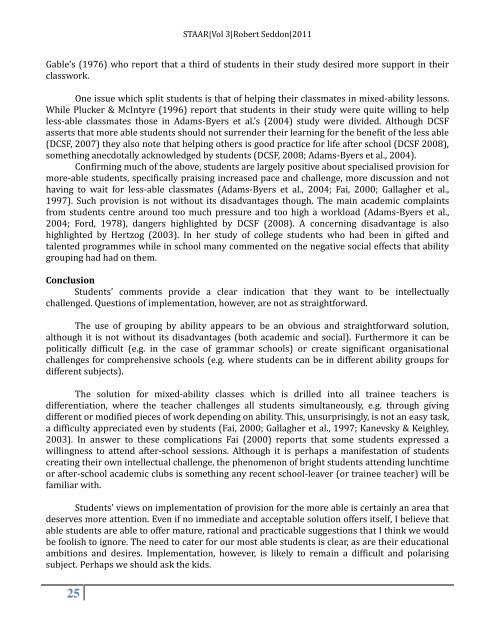STAAR Volume 3 - St. Anne's MCR
STAAR Volume 3 - St. Anne's MCR
STAAR Volume 3 - St. Anne's MCR
You also want an ePaper? Increase the reach of your titles
YUMPU automatically turns print PDFs into web optimized ePapers that Google loves.
25<br />
<strong>STAAR</strong>|Vol 3|Robert Seddon|2011<br />
Gable’s (1976) who report that a third of students in their study desired more support in their<br />
classwork.<br />
One issue which split students is that of helping their classmates in mixed-ability lessons.<br />
While Plucker & McIntyre (1996) report that students in their study were quite willing to help<br />
less-able classmates those in Adams-Byers et al.’s (2004) study were divided. Although DCSF<br />
asserts that more able students should not surrender their learning for the benefit of the less able<br />
(DCSF, 2007) they also note that helping others is good practice for life after school (DCSF 2008),<br />
something anecdotally acknowledged by students (DCSF, 2008; Adams-Byers et al., 2004).<br />
Confirming much of the above, students are largely positive about specialised provision for<br />
more-able students, specifically praising increased pace and challenge, more discussion and not<br />
having to wait for less-able classmates (Adams-Byers et al., 2004; Fai, 2000; Gallagher et al.,<br />
1997). Such provision is not without its disadvantages though. The main academic complaints<br />
from students centre around too much pressure and too high a workload (Adams-Byers et al.,<br />
2004; Ford, 1978), dangers highlighted by DCSF (2008). A concerning disadvantage is also<br />
highlighted by Hertzog (2003). In her study of college students who had been in gifted and<br />
talented programmes while in school many commented on the negative social effects that ability<br />
grouping had had on them.<br />
Conclusion<br />
<strong>St</strong>udents’ comments provide a clear indication that they want to be intellectually<br />
challenged. Questions of implementation, however, are not as straightforward.<br />
The use of grouping by ability appears to be an obvious and straightforward solution,<br />
although it is not without its disadvantages (both academic and social). Furthermore it can be<br />
politically difficult (e.g. in the case of grammar schools) or create significant organisational<br />
challenges for comprehensive schools (e.g. where students can be in different ability groups for<br />
different subjects).<br />
The solution for mixed-ability classes which is drilled into all trainee teachers is<br />
differentiation, where the teacher challenges all students simultaneously, e.g. through giving<br />
different or modified pieces of work depending on ability. This, unsurprisingly, is not an easy task,<br />
a difficulty appreciated even by students (Fai, 2000; Gallagher et al., 1997; Kanevsky & Keighley,<br />
2003). In answer to these complications Fai (2000) reports that some students expressed a<br />
willingness to attend after-school sessions. Although it is perhaps a manifestation of students<br />
creating their own intellectual challenge, the phenomenon of bright students attending lunchtime<br />
or after-school academic clubs is something any recent school-leaver (or trainee teacher) will be<br />
familiar with.<br />
<strong>St</strong>udents’ views on implementation of provision for the more able is certainly an area that<br />
deserves more attention. Even if no immediate and acceptable solution offers itself, I believe that<br />
able students are able to offer mature, rational and practicable suggestions that I think we would<br />
be foolish to ignore. The need to cater for our most able students is clear, as are their educational<br />
ambitions and desires. Implementation, however, is likely to remain a difficult and polarising<br />
subject. Perhaps we should ask the kids.


